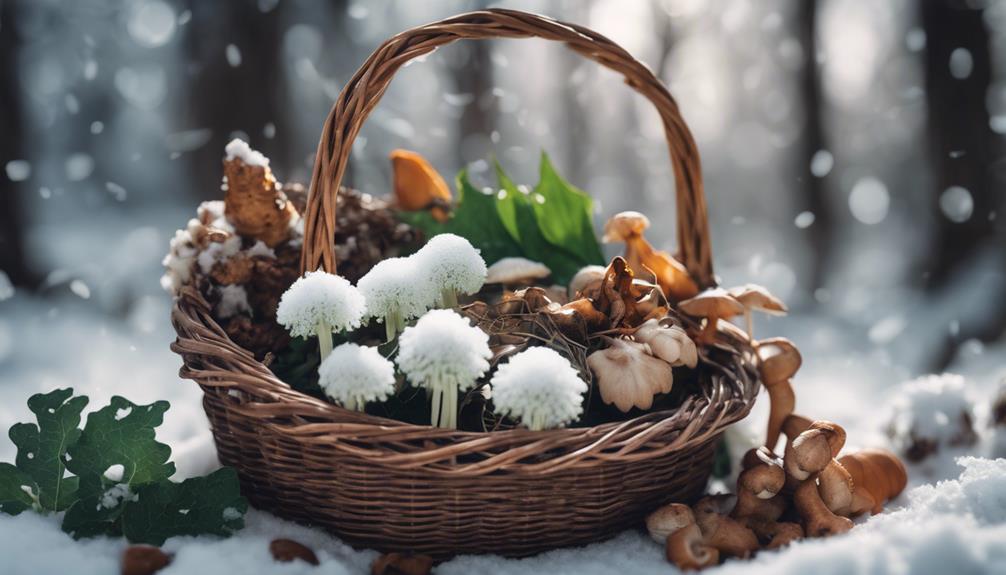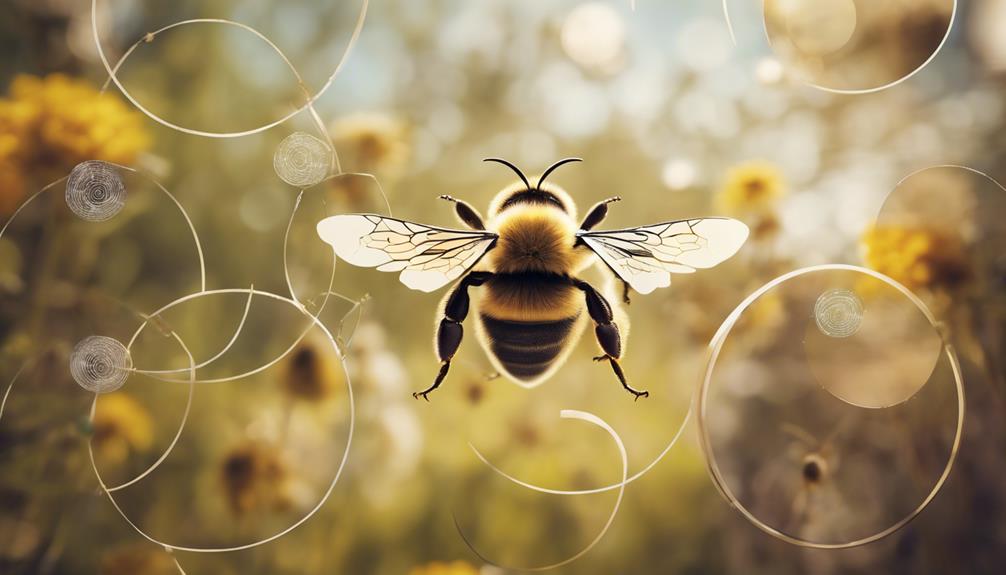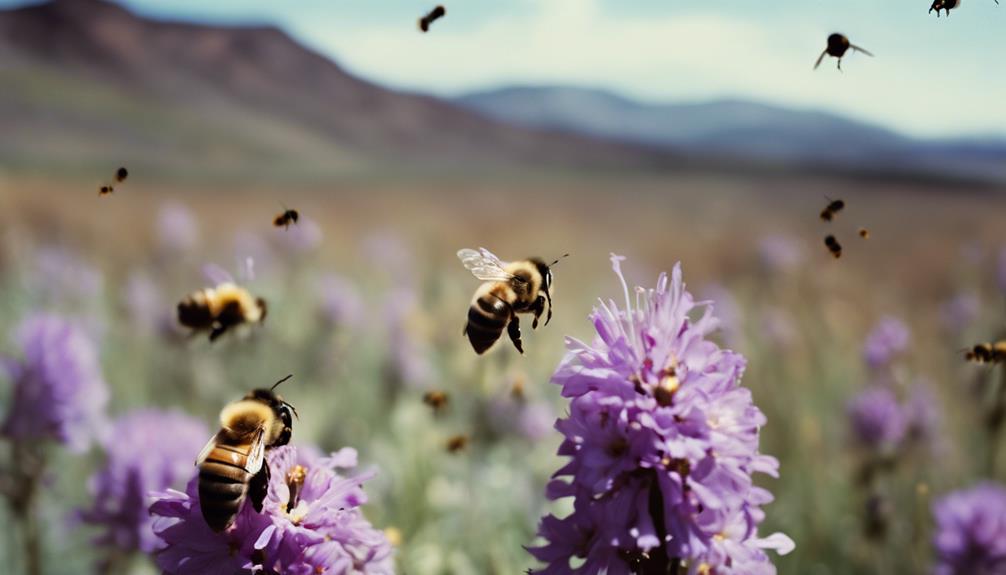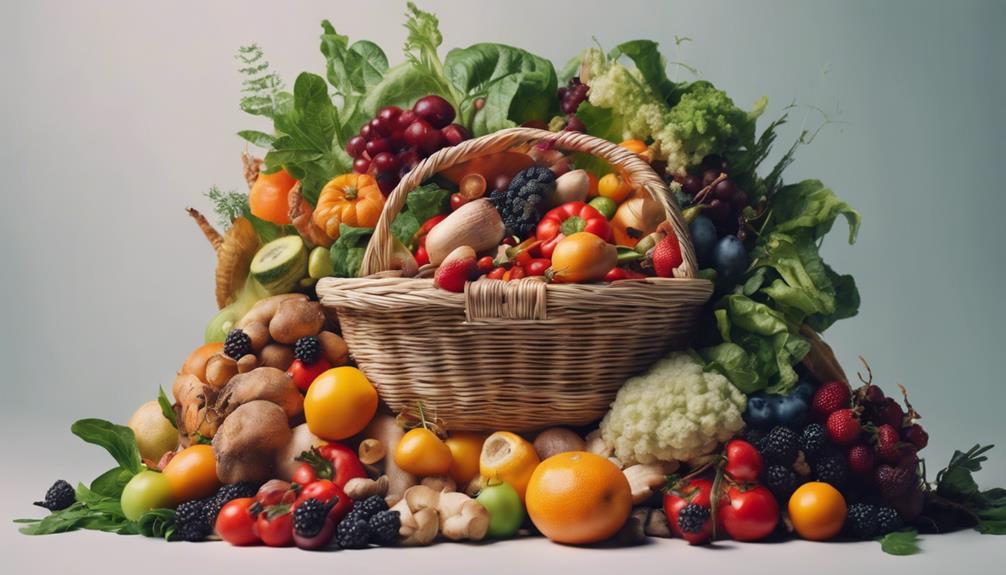You can forage a surprising array of wild edibles in the UK during January, from earthy winter greens like nettles and chickweed to energy-rich roots like burdock and horseradish. Ripe rosehips are rich in vitamin C, while hazelnuts can be enjoyed as a crunchy snack. Seaweeds like dulse, kelp, and bladderwrack add umami flavor, and winter mushrooms like velvet shanks offer earthy flavors. As you venture outdoors, you'll discover these hidden gems and uncover more seasonal treasures, revealing a world of culinary delights beyond the usual winter fare. Explore further to uncover more of winter's secrets.
Key Takeaways
- In January, forage for ripe rosehips, rich in vitamin C, and hazelnuts, perfect for cooking and snacking.
- Winter greens like nettles, chickweed, and few flowered garlic thrive in cold weather, offering earthy flavors and nutrients.
- Burdock and horseradish roots are energy-rich and can be harvested during winter, adding depth to soups and stews.
- Seaweeds like dulse, kelp, and bladderwrack provide umami flavor and minerals, making them a great winter foraging find.
- Winter mushrooms like velvet shanks add an earthy flavor to dishes, and birch trees offer edible inner bark and sap for a refreshing drink.
Winter's Hidden Edible Delights
As you venture out into the UK's winter landscape in January, you'll be surprised to discover a hidden world of edible delights waiting to be unearthed. Winter foraging often gets a bad rap, but it's an excellent time to find some fantastic ingredients.
Nettles, for instance, are a great find in January, and can be used in soups, stews, or even as a tea. Chickweed, with its spinach-like taste, is another great find that thrives year-round.
If you're feeling adventurous, you can try your hand at harvesting energy-rich roots like burdock and horseradish. These can be roasted, pickled, or added to soups for an extra boost of flavor and nutrition.
And if you're near the coast, don't forget to check out the seaweeds like dulse, kelp, and bladderwrack. These can add a delicious umami flavor to your winter dishes.
Foraged Fruits and Nuts in January

Venture into hedgerows, paths, or abandoned gardens, and you'll likely stumble upon ripe rosehips, packed with vitamin C and ready for the picking in January. These foraged fruits are a winter gem, offering a natural boost to your immune system during the colder months.
You might also come across crab apples, often overlooked but perfect for cooking and baking. In woodlands or hedgerows, keep an eye out for hazelnuts, which remain on trees into the winter. Simply remove the protective husks and enjoy as a crunchy snack.
Winter months can be a great time to forage for fruits and nuts, as the crowds are smaller and the landscape is less dense. By doing so, you'll not only get to enjoy the fruits of your labor but also connect with nature during a time when it's often overlooked.
Wild Greens and Roots to Discover

Winter's chill doesn't mean your foraging basket has to stay empty – January's wild greens and roots are waiting to be discovered. As you venture out, keep an eye out for hardy winter greens like nettles and few flowered garlic, which thrive in the cold weather. Chickweed, with its spinach-like taste, is another common find in gardens and veggie patches.
| Wild Green/Root | Taste/Texture | Where to Find |
|---|---|---|
| Nettle Leaves | Earthy, slightly bitter | Sheltered areas, woodland edges |
| Few Flowered Garlic | Pungent, garlicky | Woodlands, damp areas |
| Burdock Roots | Earthy, starchy | Woodland edges, hedgerows |
| Horseradish Roots | Pungent, spicy | Woodland edges, hedgerows |
When foraging in January, look for burdock and horseradish roots, which provide a rich source of energy. Young nettle leaves can be found in sheltered areas, offering a nutritious wild green to harvest. Few flowered garlic, with its distinctive appearance, can be found in woodlands or damp areas during the winter months. Happy foraging!
Seasonal Treasures Beyond Fruits

You'll discover a wealth of seasonal treasures beyond fruits in January, from seaweeds to mushrooms and edible roots, offering a diverse range of flavors and textures to enhance your winter foraging experience.
As you venture out, you'll find that winter foraging in the UK is more than just about hardy greens like nettles, chickweed, and few-flowered garlic.
- Seaweeds like dulse, kelp, and bladderwrack are still accessible near the coast during the winter months, providing an invigorating and nutritious addition to your meals.
- Foraging for edible roots like burdock and horseradish can provide energy-rich options in the UK winter, while birch trees offer inner bark that can be ground into a flour substitute and birch sap that can be tapped for an invigorating drink.
- Winter mushrooms such as velvet shanks and oyster mushrooms can be found with advanced knowledge and caution in January, adding an earthy flavor to your winter dishes.
These seasonal treasures will add variety and depth to your winter foraging experience, allowing you to make the most of the UK's winter landscape.
Culinary Delights From Winter Foraging

As you explore the UK's winter landscape, you uncover a treasure trove of culinary delights, from rosehips bursting with vitamin C to hazelnuts hidden in woodlands and hedgerows. Winter foraging in the UK offers a surprising array of flavors and textures to spice up your meals.
| Culinary Delight | Description | Habitat |
|---|---|---|
| Rosehips | Packed with vitamin C, sweet and tangy | Hedgerows, abandoned gardens |
| Hazelnuts | Rich and nutty, hidden in protective husks | Woodlands, hedgerows |
| Winter Greens | Hardy and nutritious, perfect for salads | Woodlands, hedgerows, gardens |
Hardy winter greens like chickweed, nettles, and few flowered garlic offer nutritious options for foragers in January. Seaweeds like dulse, kelp, and bladderwrack are still accessible near the coast, providing a rich source of minerals and vitamins in winter. As you venture into winter foraging, you'll discover a world of culinary delights hidden in plain sight. So, grab your basket and get foraging!
Frequently Asked Questions
What Can You Forage in January in the Uk?
You can forage winter greens like nettles and chickweed, seaweeds like dulse and kelp, hazelnuts, and rosehips in January in the UK, but be cautious when searching for mushrooms like velvet shanks and oyster mushrooms.
Is It Illegal to Forage for Foliage in the Uk?
You might be surprised to know that over 20% of British people forage for wild food! As for your question, it's not entirely illegal to forage for foliage in the UK, but you must make sure you're not on private land or protected areas, and respect conservation laws. Additionally, it’s important to ensure that you’re foraging in a sustainable way, taking only what you need and leaving enough for wildlife and the ecosystem to thrive. Foraging moss in the UK, for example, should be done carefully, as moss plays a critical role in maintaining moisture and supporting biodiversity in forests and wetlands. Always check local regulations and guidelines to avoid causing harm to the environment while enjoying what nature has to offer.
What Is Edible for Winter Foraging?
You're wondering what's edible for winter foraging? You'll find nettles rich in vitamins, dandelions for versatile dishes, and wild garlic in woodland areas, all waiting to be discovered and added to your winter menu!
What Foods Are Winter Foraged?
You'll discover winter foraged foods like nettles, chickweed, and wild garlic, which add unique flavors and nutrients to your meals. You'll also find hazelnuts, rosehips, and edible seaweeds like dulse and kelp along the coast.
Conclusion
As you bundle up to face the chill of January, remember that winter's barren landscape still holds hidden gems.
Don't let the frost fool you – there's more to forage than just a few sad, wilted leaves.
From sweet, frozen rose hips to peppery wild mustard, the UK's winter landscape is full of unexpected delights waiting to be discovered.
So, grab your wellies and get foraging – your taste buds (and the environment) will thank you.
Who needs a fancy supermarket when nature's own pantry is right outside?










